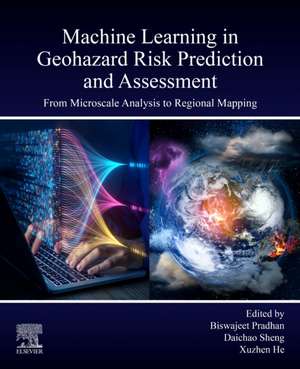Machine Learning in Geohazard Risk Prediction and Assessment: From Microscale Analysis to Regional Mapping
Editat de Biswajeet Pradhan, Daichao Sheng, Xuzhen Heen Limba Engleză Paperback – iul 2025
- Introduces machine-learning techniques in the risk management of geo-hazards, particularly recent developments
- Covers a broader category of research and machine-learning techniques that can be applied, from microscopic modeling to constitutive modeling, to physics-based numerical modeling, to regional susceptibility mapping
- Contains contributions from top researchers around the world, including authors from the UK, USA, Australia, Austria, China, and India
Preț: 826.34 lei
Preț vechi: 908.06 lei
-9% Nou
Puncte Express: 1240
Preț estimativ în valută:
158.14€ • 163.15$ • 133.84£
158.14€ • 163.15$ • 133.84£
Carte nepublicată încă
Doresc să fiu notificat când acest titlu va fi disponibil:
Se trimite...
Preluare comenzi: 021 569.72.76
Specificații
ISBN-13: 9780443236631
ISBN-10: 0443236631
Pagini: 325
Dimensiuni: 191 x 235 mm
Editura: ELSEVIER SCIENCE
ISBN-10: 0443236631
Pagini: 325
Dimensiuni: 191 x 235 mm
Editura: ELSEVIER SCIENCE
Cuprins
Part 1: Machine learning methods and connections between different parts.
1. Machine learning methods
2. Connections between studies across different scales
3. Summary and outlook
Part 2: Machine learning in microscopic modelling of geo-materials.
4. Machine-learning-enabled discrete element method
5. Machine learning in micromechanics based virtual laboratory testing
6. Integrating X-ray CT and machine learning for better understanding of granular materials
7. Summary and outlook
Part 3: Machine learning in constitutive modelling of geo-materials.
8. Thermodynamics-driven deep neural network as constitutive equations
9. Deep active learning for constitutive modelling of granular materials
10. Summary and outlook
Part 4: Machine learning in design of geo-structures.
11. Deep learning for surrogate modelling for geotechnical risk analysis
12. Deep learning for geotechnical optimization of designs
13. Deep learning for time series forecasting in geotechnical engineering
14. Summary and outlook
Part 5: Machine learning in geo-risk susceptibility mapping for regions of various sizes.
15. Deep learning and ensemble modeling of debris flows, mud flows and rockfalls.
16. Integrating machine learning and physical-based models in landslide susceptibility and hazard mapping.
17. Explainable AI (XAI) in landslide susceptibility, hazard, vulnerability and risk assessment.
18. New approaches for data collection for susceptibility mapping
19. Summary and outlook
1. Machine learning methods
2. Connections between studies across different scales
3. Summary and outlook
Part 2: Machine learning in microscopic modelling of geo-materials.
4. Machine-learning-enabled discrete element method
5. Machine learning in micromechanics based virtual laboratory testing
6. Integrating X-ray CT and machine learning for better understanding of granular materials
7. Summary and outlook
Part 3: Machine learning in constitutive modelling of geo-materials.
8. Thermodynamics-driven deep neural network as constitutive equations
9. Deep active learning for constitutive modelling of granular materials
10. Summary and outlook
Part 4: Machine learning in design of geo-structures.
11. Deep learning for surrogate modelling for geotechnical risk analysis
12. Deep learning for geotechnical optimization of designs
13. Deep learning for time series forecasting in geotechnical engineering
14. Summary and outlook
Part 5: Machine learning in geo-risk susceptibility mapping for regions of various sizes.
15. Deep learning and ensemble modeling of debris flows, mud flows and rockfalls.
16. Integrating machine learning and physical-based models in landslide susceptibility and hazard mapping.
17. Explainable AI (XAI) in landslide susceptibility, hazard, vulnerability and risk assessment.
18. New approaches for data collection for susceptibility mapping
19. Summary and outlook
